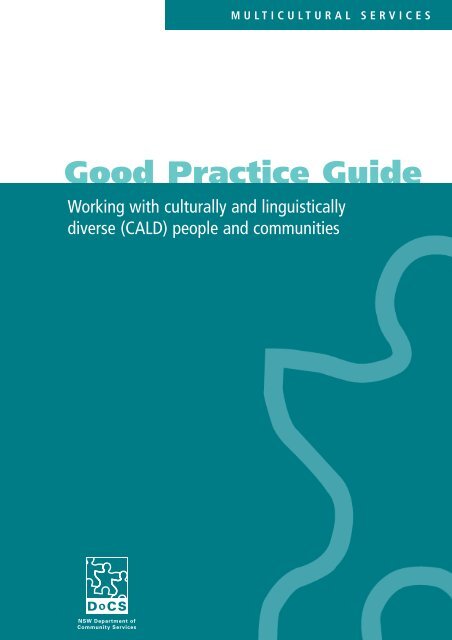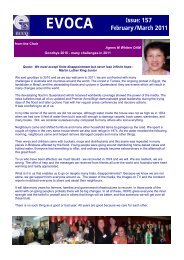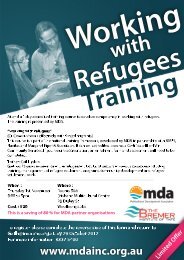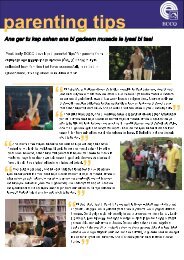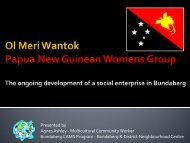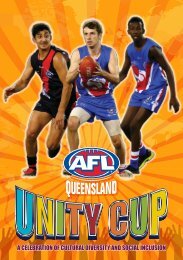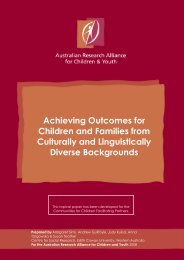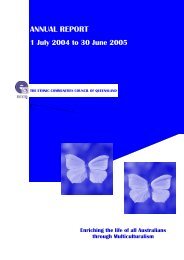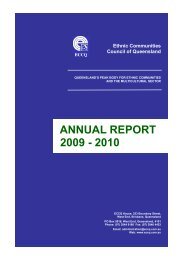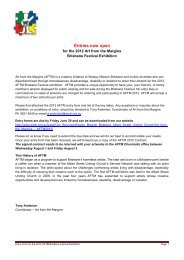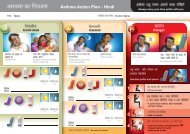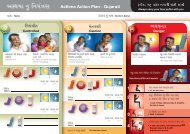Good Practice Guide
CALD Good practice guide
CALD Good practice guide
You also want an ePaper? Increase the reach of your titles
YUMPU automatically turns print PDFs into web optimized ePapers that Google loves.
MULTICULTURAL SERVICES<br />
<strong>Good</strong> <strong>Practice</strong> <strong>Guide</strong><br />
Working with culturally and linguistically<br />
diverse (CALD) people and communities
GOOD PRACTICE GUIDE<br />
CONTENTS<br />
1 Introduction . . . . . . . . . . . . . . . . . . . . . . . . . . . . . . . . . . . . . . . . . . . . . . 2<br />
2 Approach informing this guide . . . . . . . . . . . . . . . . . . . . . . . . . . . . . . . . . . 3<br />
3 Who are migrants, refugees and asylum seekers? . . . . . . . . . . . . . . . . . . 4<br />
3.1 Migrants . . . . . . . . . . . . . . . . . . . . . . . . . . . . . . . . . . . . . . . . . . . . . . . . . . 4<br />
3.2 Refugees . . . . . . . . . . . . . . . . . . . . . . . . . . . . . . . . . . . . . . . . . . . . . . . . . . 4<br />
3.3 Refugee children and young people . . . . . . . . . . . . . . . . . . . . . . . . . . . . . 5<br />
3.4 Unaccompanied minors . . . . . . . . . . . . . . . . . . . . . . . . . . . . . . . . . . . . . . 5<br />
3.5 Asylum seekers . . . . . . . . . . . . . . . . . . . . . . . . . . . . . . . . . . . . . . . . . . . . . 6<br />
3.6 Small and emerging communities . . . . . . . . . . . . . . . . . . . . . . . . . . . . . . 7<br />
4 <strong>Good</strong> cross-cultural practice . . . . . . . . . . . . . . . . . . . . . . . . . . . . . . . . . . . . 8<br />
4.1 Staff development . . . . . . . . . . . . . . . . . . . . . . . . . . . . . . . . . . . . . . . . . . 8<br />
4.2 Assessment and casework . . . . . . . . . . . . . . . . . . . . . . . . . . . . . . . . . . . . 10<br />
5 Interpreters . . . . . . . . . . . . . . . . . . . . . . . . . . . . . . . . . . . . . . . . . . . . . . . . . . . 11<br />
5.1 Role of interpreters . . . . . . . . . . . . . . . . . . . . . . . . . . . . . . . . . . . . . . . . . . 11<br />
5.2 Ethical considerations . . . . . . . . . . . . . . . . . . . . . . . . . . . . . . . . . . . . . . . . 12<br />
5.3 Determining the need for an interpreter . . . . . . . . . . . . . . . . . . . . . . . . . 12<br />
5.4 Do not use friends or family as interpreters . . . . . . . . . . . . . . . . . . . . . . . 13<br />
5.5 Requesting an interpreter . . . . . . . . . . . . . . . . . . . . . . . . . . . . . . . . . . . . . 14<br />
5.6 Telephone interpreters . . . . . . . . . . . . . . . . . . . . . . . . . . . . . . . . . . . . . . . 15<br />
5.7 On-site interpreters . . . . . . . . . . . . . . . . . . . . . . . . . . . . . . . . . . . . . . . . . 16<br />
6 Interpreter facilitated interviews with children and young people . . . . 21<br />
6.1 Preparation . . . . . . . . . . . . . . . . . . . . . . . . . . . . . . . . . . . . . . . . . . . . . . . . 21<br />
6.2 Conducting interviews . . . . . . . . . . . . . . . . . . . . . . . . . . . . . . . . . . . . . . . 21<br />
7 Translators . . . . . . . . . . . . . . . . . . . . . . . . . . . . . . . . . . . . . . . . . . . . . . . . . . . 23<br />
7.1 Translating docuements . . . . . . . . . . . . . . . . . . . . . . . . . . . . . . . . . . . . . . 23<br />
8 Feedback . . . . . . . . . . . . . . . . . . . . . . . . . . . . . . . . . . . . . . . . . . . . . . . . . . . . . 26<br />
9 Charges . . . . . . . . . . . . . . . . . . . . . . . . . . . . . . . . . . . . . . . . . . . . . . . . . . . . . 27<br />
10 DoCS' language support staff . . . . . . . . . . . . . . . . . . . . . . . . . . . . . . . . . . . 28<br />
10.1 Multicultural caseworkers in identified positions . . . . . . . . . . . . . . . . . . . 28<br />
10.2 Community Language Allowance Scheme (CLAS) . . . . . . . . . . . . . . . . . . 28<br />
11 Other resources . . . . . . . . . . . . . . . . . . . . . . . . . . . . . . . . . . . . . . . . . . . . . . . 30<br />
1
GOOD PRACTICE GUIDE<br />
INTRODUCTION<br />
The NSW Department of<br />
Community Services (DoCS)<br />
has particular responsibilities<br />
for child protection and<br />
community well being. These<br />
are outlined in legislation<br />
including the Children and<br />
Young Persons (Care and<br />
Protection) Act 1998 and the<br />
Community Welfare Act 1987.<br />
In light of DoCS’ responsibilities under<br />
these and other Acts and in order to meet<br />
general principles of social justice, the<br />
Department provides a range of services<br />
to individuals and families directly as well<br />
as in partnership with other government<br />
and non government agencies.<br />
DoCS is committed to fairness in the<br />
distribution of resources, recognising and<br />
promoting diversity, improving access to<br />
services and making opportunities<br />
available to allow genuine participation<br />
and consultation. This commitment is<br />
upheld in the Principles of<br />
Multiculturalism Act 2000, and The Right<br />
to Better Service - DoCS Ethnic Affairs<br />
Policy Directions statement.<br />
This <strong>Guide</strong> has been developed to provide<br />
practical information to further assist staff<br />
in their practice in an increasingly complex<br />
and diverse environment. More specifically,<br />
the <strong>Guide</strong> highlights the importance of<br />
ensuring the development of knowledge,<br />
skills and attitudes that value culture,<br />
cultural and linguistic diversity, and<br />
embrace cultural competency.<br />
DoCS' Business Help Topic on Working<br />
With Culturally and Linguistically Diverse<br />
Children, Young People and Families is<br />
also available as a resource to staff.<br />
It further expands on procedures<br />
required to ensure compliance with the<br />
Children and Young Persons (Care and<br />
Protection) Act 1998 when working with<br />
children, young people, families and<br />
communities from culturally and<br />
linguistically diverse backgrounds.<br />
This <strong>Guide</strong> does not outline the specific<br />
issues and strategies required to work<br />
effectively with diverse Indigenous<br />
communities in NSW. There are specific<br />
policies and programs that do this within<br />
DOCS and staff are encouraged to<br />
familiarise themselves with these.<br />
Whilst this <strong>Guide</strong> recognises the<br />
centrality and importance of Indigenous<br />
history and context, it specifically refers<br />
to migrant, refugee and asylum seeker<br />
individuals, families and communities<br />
when using the term "culturally and<br />
linguistically diverse".<br />
2
GOOD PRACTICE GUIDE<br />
2. APPROACH INFORMING THIS GUIDE<br />
There are many approaches<br />
that have been used in ongoing<br />
efforts to ensure relevant,<br />
appropriate and high quality<br />
services to all.<br />
One approach includes<br />
increasing the cultural<br />
sensitivity of staff. However,<br />
it is becoming clear that cross<br />
cultural sensitivity is only one<br />
component of a set of skills<br />
needed to achieve quality<br />
service delivery to children,<br />
young people and families<br />
from diverse cultural and<br />
linguistic backgrounds.<br />
As such, cross cultural competence is being<br />
increasingly applied by human services.<br />
The difference is an important one to<br />
understand:<br />
• Sensitivity: refers to being open<br />
and empathic towards a particular<br />
group's issues and concerns<br />
• Competency: includes sensitivity,<br />
knowledge, skills, actions and<br />
awareness of one’s own biases.<br />
Accordingly, the following principles<br />
inform the approach:<br />
• cross cultural competence is not<br />
additional, but integral to the core<br />
skill sets required of staff to work<br />
effectively with clients from culturally<br />
and linguistically diverse backgrounds<br />
• whilst all children, young people and<br />
families are characterised by diverse<br />
needs, backgrounds and experience,<br />
these are more pronounced for those<br />
from culturally and linguistically<br />
diverse backgrounds, and thereby<br />
require specific strategies to ensure<br />
appropriate and equitable outcomes<br />
• cross cultural competency requires<br />
a recognition that cultural<br />
considerations influence all levels<br />
of the client-provider encounter<br />
including the assessment, case work<br />
practice, communication process,<br />
and service utilisation<br />
• cultures are not static but dynamic<br />
and evolving<br />
• self awareness and the examination<br />
of one's own cultural identity and<br />
values that operate both at the<br />
conscious and unconscious levels<br />
is critical<br />
• there is a need to recognise that<br />
differences in language, age, culture,<br />
socio-economic status, political and<br />
religious beliefs, sexual orientation,<br />
and life experience add challenging<br />
dimensions to the dynamics of cross<br />
cultural interactions<br />
• issues of power and privilege are<br />
legitimate aspects of understanding<br />
and responding appropriately to<br />
others across cultural boundaries<br />
• cross cultural competence is not<br />
a fixed set of skills that can be<br />
obtained or mastered. Instead,<br />
developing cross cultural competence<br />
is an ongoing process that involves<br />
lifelong learning<br />
• change is both an individual process<br />
and an organisational/systems<br />
process. Strategies for enhancing<br />
individual competence must take<br />
place in concert with efforts to<br />
modify policies and programs.<br />
3
GOOD PRACTICE GUIDE<br />
3. WHO ARE MIGRANTS, REFUGEES AND ASYLUM SEEKERS?<br />
The terms "migrant",<br />
"refugee" and "asylum seeker"<br />
are frequently used in close<br />
association and often<br />
interchangeably, however they<br />
have quite distinct meanings.<br />
Understanding the difference<br />
between the three is important<br />
when working with migrant,<br />
refugee and asylum seeker<br />
clients with culturally and<br />
linguistically diverse<br />
backgrounds.<br />
3.1 Migrants<br />
Australia has a long history of migration.<br />
Since 1788 when the First Fleet arrived<br />
and non-Aboriginal settlement began,<br />
Australia has been known as a<br />
destination for migrants. In 2001 40%<br />
of Australians were identified as migrants<br />
or children of migrants 1 .<br />
Generally migrants can plan their<br />
migration processes and make a<br />
conscious choice to come to Australia.<br />
There are many reasons why people<br />
choose to migrate to Australia, including<br />
family reunification, economic<br />
considerations and lifestyle choices.<br />
Migrants' pre-arrival experiences are,<br />
in the main, trauma free.<br />
Migrants have the freedom to choose<br />
whether they go back to their country of<br />
origin for short periods or permanently.<br />
3.2 Refugees<br />
According to the 1951 Convention<br />
Relating to the Status of Refugees and<br />
its 1967 Protocol, refugees are defined<br />
as any person who has left their country<br />
and is unable or unwilling to return to it<br />
'owing to a well founded fear of being<br />
persecuted for reasons of race, religion,<br />
nationality, membership of a particular<br />
social group or political opinion'.<br />
The United Nations High Commissioner<br />
for Refugees (UNHCR) was established<br />
in 1951 to provide international<br />
protection and seek durable solutions<br />
to refugees' plight 2 .<br />
Refugees are people who have been<br />
forced to leave their country of citizenship<br />
because they have been persecuted.<br />
They often have little or no opportunity<br />
to prepare themselves physically or<br />
psychologically for their new life.<br />
Refugees often have little idea of which<br />
country they will end up in. Refugees who<br />
come to Australia often have little or no<br />
understanding about Australian society,<br />
culture or physical and human geography.<br />
Many have little or no English proficiency<br />
and no familial or social connections in<br />
Australia. Consequently social isolation is<br />
a pronounced feature of refugees' lives.<br />
Refugees come to Australia as permanent<br />
residents under the Refugee Special<br />
Humanitarian Program, the off-shore<br />
humanitarian component of the migration<br />
program. Refugees may also arrive in<br />
Australia without having their claims for<br />
refugee status assessed or validated. In<br />
these instances refugees may apply for<br />
asylum on-shore. On-shore applicants are<br />
generally referred to as 'asylum seekers'.<br />
4<br />
1 Acting Federal Race Discrimination Commissioner (2001), Face the Facts, Some Questions and Answers About Immigration, Refugees and Indigenous Affairs, Human Rights and Equal<br />
Opportunity Commission, p 5<br />
2 Victorian Foundation for the Survivors of Torture and Office of the United Nations High Commissioner for Refugees (2002), Refugee Resettlement An International Handbook to <strong>Guide</strong> Reception<br />
and Integration, Foundation House, p 1
GOOD PRACTICE GUIDE<br />
3. WHO ARE MIGRANTS, REFUGEES AND ASYLUM SEEKERS?<br />
Pre-arrival trauma is a significant factor<br />
in refugees' experiences. The proportion<br />
of refugees who have experienced severe<br />
pre-arrival trauma varies considerably.<br />
Rates of post traumatic stress disorder<br />
range between 39 percent and 100<br />
percent, compared with 1 percent in the<br />
general population 3 . Rates of depression<br />
in refugees have been estimated between<br />
47-72 percent 4 .<br />
3.3 Refugee children and<br />
young people<br />
Having experienced varying degrees of<br />
dislocation, deprivation, disruption and<br />
loss, refugee children and young people<br />
often experience similar psychological<br />
trauma as adults, including levels of<br />
anxiety associated with exposure to<br />
traumatic events 5 . Often the loss of, or<br />
disruption to, significant relationships in<br />
the family and community affect refugee<br />
children's attachment behaviours, and<br />
their capacity to form meaningful and<br />
supportive relationships.<br />
3.4 Unaccompanied Minors<br />
A child or young person under the age of<br />
18 who has been separated from both<br />
parents and is not being cared for by an<br />
adult who - by law or custom - has the<br />
responsibility to do so, is known as an<br />
unaccompanied minor. Around 3 - 5<br />
percent of all refugees are unaccompanied<br />
minors 6 . Unaccompanied minors fall into<br />
one of two categories, detached or<br />
unattached.<br />
A detached refugee minor is a child or<br />
young person under the age of 18, who<br />
has entered Australia as a refugee and is<br />
in the care of a close adult relative who<br />
is not a parent.<br />
An unattached refugee minor is a<br />
child or young person under the age<br />
of 18, who has entered Australia as a<br />
non-citizen and who intends to become,<br />
or is intended to become a permanent<br />
resident. When they enter Australia, they<br />
are not in the care of a parent or a<br />
relative who is at least 21 years of age.<br />
Unaccompanied minors may be granted<br />
either Permanent Protection Visas (PPVs)<br />
or Temporary Protection Visas (TPVs).<br />
Australia has specific procedures for<br />
assessing care arrangements for<br />
unaccompanied refugee minors.<br />
All unaccompanied refugee minors receive<br />
settlement assistance. The responsibility<br />
for the provision of prompt and culturally<br />
sensitive services that address their<br />
complex needs, rests with the Department<br />
of Community Services.<br />
Unattached minors become wards<br />
of the Minister for Immigration and<br />
Multicultural and Indigenous Affairs.<br />
3 ibid, p 233,<br />
4 ibid, p 233,<br />
5 ibid, p 234<br />
6 ibid, p 274.<br />
5
GOOD PRACTICE GUIDE<br />
3. WHO ARE MIGRANTS, REFUGEES AND ASYLUM SEEKERS?<br />
In NSW, where unattached minors<br />
live outside of detention centres, the<br />
Commonwealth government delegates<br />
responsibilities for guardianship to the<br />
Director-General of the Department of<br />
Community Services (DoCS). Where this<br />
occurs, DoCS often makes arrangements<br />
with care providers who share the child's<br />
religious or cultural backgrounds.<br />
If an unaccompanied refugee minor in the<br />
community is suspected to be at risk of<br />
harm, regardless of their refugee status,<br />
DoCS must respond in the same way<br />
as for any child or young person.<br />
3.5 Asylum seekers<br />
When people come to Australia seeking<br />
refugee asylum on-shore, they are<br />
identified as 'asylum seekers' until their<br />
claims for refugee status are validated or<br />
disproved. In the past, once an asylum<br />
seeker's refugee status was validated they<br />
were granted Permanent Protection Visas<br />
(PPV). PPV holders were allowed<br />
permanent residency status. This granted<br />
the same entitlements as available to<br />
refugees who had entered Australia under<br />
the Refugee Program.<br />
Recent legislative changes introduced<br />
Temporary Protection Visas (TPVs).<br />
Currently all on-shore asylum seekers<br />
who have a valid claim for refugee status<br />
are granted a TPV for a three year period.<br />
During this time they are not able to<br />
bring their families to Australia and<br />
their visa ceases if they leave Australia.<br />
After 30 months TPV holders can apply<br />
for a further protection visa 7 , but they<br />
are eligible for a strictly limited range of<br />
settlement assistance/services that are<br />
routinely provided to permanent residents 8 .<br />
All refugees have at one time been<br />
asylum seekers until their status as<br />
'refugees' has been assessed and<br />
validated. Often asylum seekers are<br />
held at immigration detention centres<br />
while the process of determination is<br />
conducted. Asylum seekers whose claim<br />
to refugee status has failed - as well as<br />
people who arrive in Australia, stay<br />
unlawfully and do not apply for refugee<br />
status - may be held in detention until<br />
they are removed from Australia 9 .<br />
6<br />
7 Department of Immigration and Multicultural and Indigenous Affairs, 27 August 2004, Seeking Asylum Within Australia, (online), Commonwealth of Australia, Available from:<br />
http://www.dimia.gov.au/refugee/seeking_asylum.htm http: (Accessed 17 January 2005)<br />
8 Department of Immigration and Multicultural and Indigenous Affairs, 20 November 2003, Assistance for Asylum Seekers in Australia, (online), Commonwealth of Australia, Available from:<br />
http://www.immi.gov.au/facts/index.htm#humanitarian (Accessed 17 January 2005)<br />
9 Acting Federal Race Discrimination Commissioner (2001), Face the Facts, Some Questions and Answers About Immigration, Refugees and Indigenous Affairs, p7
GOOD PRACTICE GUIDE<br />
3. WHO ARE MIGRANTS, REFUGEES AND ASYLUM SEEKERS?<br />
3.6 Small and Emerging<br />
Communities<br />
The term 'Small and Emerging<br />
Communities' describes a section of<br />
recently arrived migrant and refugee<br />
communities who are still in the process<br />
of settlement, and facing a number of<br />
concurrent settlement related challenges.<br />
Small and emerging communities'<br />
characteristics include:<br />
• being small in number (generally up<br />
to 7,000)<br />
• having little or no familiarity with<br />
Western culture and lifestyle<br />
• lacking extended family members<br />
and community / religious leaders<br />
• being geographically dispersed.<br />
As a consequence of the majority of<br />
community members being new arrivals<br />
and therefore at 'survival level' for the<br />
first few years, it is difficult for such<br />
communities to be involved in self-help<br />
and community development.<br />
Although many of the characteristics<br />
of small and emerging communities<br />
are common to all new settlers, more<br />
specific needs and gaps also exist.<br />
Some of these include:<br />
• difficulties in accessing or obtaining<br />
language services as there is a<br />
limited number of suitably<br />
qualified/accredited interpreters<br />
and translators<br />
• lack of community<br />
counsellors/mediators to attend to<br />
family disputes or crises<br />
• lack of availability of written material<br />
in required languages due to<br />
constraints around reproducing<br />
written information in small quantities<br />
• difficulty in maintaining<br />
confidentiality and anonymity<br />
due to size of community<br />
• lack of collective resources<br />
• no special consideration in service<br />
delivery due to small size and<br />
geographic dispersal coupled with<br />
political, ethnic or religious<br />
differences within the community<br />
• lack of demographic data for<br />
planning purposes.<br />
7
GOOD PRACTICE GUIDE<br />
4. GOOD CROSS-CULTURAL PRACTICE<br />
Cross cultural competence<br />
can occur at the individual,<br />
program and organisational<br />
levels. Broadly, cross cultural<br />
competence refers to the<br />
ability to relate and<br />
communicate effectively,<br />
particularly when the<br />
individuals involved in an<br />
interaction do not share the<br />
same culture, ethnicity, religion<br />
or language.<br />
It is important to note<br />
however that the process<br />
of developing cross cultural<br />
competence is not something<br />
that can be 'achieved' or<br />
one that has an 'endpoint'<br />
as such, but rather involves<br />
an ongoing learning process<br />
accompanied by attitudinal<br />
and behavioural development.<br />
4.1 Staff development<br />
The challenge is to become aware of<br />
the framework from which 'culturally<br />
different' individuals and families operate,<br />
and to also become aware<br />
of cultural assumptions influencing<br />
professional judgments.<br />
Developing cross cultural competencies<br />
can greatly assist staff in ensuring<br />
responsive, appropriate and equitable<br />
outcomes. It has multiple components<br />
that include cultural sensitivity, along<br />
with:<br />
• awareness<br />
• knowledge<br />
• skills<br />
• actions.<br />
The following strategies are set out<br />
under the four components and aim<br />
to enhance the cultural competency<br />
of staff, and assist them to safeguard<br />
the welfare of migrants, refugee and<br />
asylum seeker clients.<br />
4.1.1 Awareness<br />
The awareness component involves<br />
recognition of one's own preconceptions<br />
as well as awareness of the socio-political<br />
issues that confront children and families<br />
from culturally and linguistically<br />
diverse backgrounds.<br />
Staff working with culturally and<br />
linguistically diverse clients should:<br />
• acknowledge the impact of ethnicity<br />
and culture on own attitudes and<br />
value systems, and take those factors<br />
into account when working with<br />
various culturally and linguistically<br />
diverse groups<br />
• recognise the limits of their cultural<br />
competence and seek ongoing<br />
supervision and/or additional training<br />
and expertise from both internal and<br />
external sources<br />
• understand the role that culture and<br />
ethnicity play in the sociopsychological<br />
and economic<br />
development of culturally and<br />
linguistically diverse populations<br />
• recognise that the 'culture' that<br />
children and families bring is a<br />
source of strength and a resource<br />
that should be built upon<br />
• understand the interaction of client<br />
behaviour, client needs, cultural<br />
implications, gender and clients'<br />
ability in accessing resources<br />
and/or information.<br />
8
GOOD PRACTICE GUIDE<br />
4. GOOD CROSS-CULTURAL PRACTICE<br />
4.1.2 Knowledge<br />
Competencies in the knowledge domain<br />
involve the acquisition of factual<br />
information about different cultural<br />
groups. There are a number of ways to<br />
gather that information, but care should<br />
always be taken to recognise the vast<br />
heterogeneity of every group and avoid<br />
stereotypes, distortions, and over<br />
generalisations. Furthermore, it is<br />
important to remember that cultures are<br />
not static, but dynamic and ever changing.<br />
Staff working with culturally and<br />
linguistically diverse clients should:<br />
• understand the client's community<br />
profile, such as their country's<br />
history, population, ethnic groups,<br />
religion, history of migration and<br />
settlement in Australia, traditions,<br />
beliefs and attitudes<br />
• understand the impact of<br />
migration/settlement history and<br />
experience upon the<br />
social/psychological status of the<br />
client and their community<br />
• research and recognise the roles of<br />
family members and community<br />
structure hierarchies, values and<br />
beliefs within the clients' culture.<br />
4.1.3 Skills and action<br />
Competencies in the skills domain involve<br />
the integration of competencies in<br />
awareness and knowledge in an effort to<br />
make relevant and appropriate decisions<br />
and ensure equitable and just outcomes.<br />
Staff working with culturally and<br />
linguistically diverse clients should:<br />
• be responsive to contextual<br />
variables of ethnography<br />
(nationality, ethnicity, religion,<br />
language) and to demography<br />
(age, gender, place of residence)<br />
• be able to ask and seek out<br />
information from children, young<br />
people and parents in an open,<br />
transparent and respectful way<br />
• ensure that cultural competencies<br />
are integrated into assessment and<br />
casework practice.<br />
9
GOOD PRACTICE GUIDE<br />
4. GOOD CROSS-CULTURAL PRACTICE<br />
4.2 Assessment and<br />
casework<br />
In addition to standard processes,<br />
staff should incorporate the following<br />
strategies into assessment and casework<br />
practice when providing services to<br />
culturally and linguistically diverse clients:<br />
• acknowledge the language preferred<br />
by the client. If service delivery in the<br />
client's preferred language is not<br />
feasible, where possible and<br />
appropriate, make a referral to a bilingual<br />
worker or use interpreters<br />
• use a qualified interpreter for<br />
assessments, investigations and<br />
casework. In order to engage the<br />
correct source of help, staff need to<br />
identify the client's cultural<br />
background and linguistic skills and<br />
establish whether religious beliefs, or<br />
other factors such as age and gender<br />
require consideration when seeking<br />
an interpreter<br />
• build rapport with the client through<br />
engaging in a culturally relevant<br />
manner, such as learning to use basic,<br />
common greetings in the client's own<br />
language, and pronouncing the<br />
client's name correctly<br />
• show that the client is valued and<br />
respected as a person through deemphasising<br />
or reducing the power<br />
aspects of the situation by being<br />
polite, checking and acknowledging<br />
the client's feelings or concerns,<br />
listening pro-actively, not interrupting<br />
the client when they are speaking,<br />
nodding and making eye contact<br />
(if culturally appropriate)<br />
• acquire information about the<br />
common cultural structures and roles<br />
within the client's family and<br />
organisations of relevance to the<br />
client's cultural background<br />
• assist the client in understanding<br />
and dealing with Australian<br />
societal structures<br />
• assist the client to understand issues<br />
in the context of their own sociocultural<br />
identification<br />
• educate the client in the process<br />
of casework intervention about<br />
issues such as goals, expectations<br />
and case plans<br />
• whenever possible provide<br />
information in writing together<br />
with oral explanations<br />
• whenever possible, provide written<br />
information in the language<br />
preferred or best understood by<br />
the client.<br />
10
GOOD PRACTICE GUIDE<br />
5. INTERPRETERS<br />
The role of interpreters and<br />
translators is different.<br />
The differences between the<br />
use of interpreters and<br />
translators include:<br />
• interpreters refer to the<br />
spoken word<br />
• translators refer to the<br />
written word.<br />
5.1 Role of interpreters<br />
The role of an interpreter is to provide a<br />
clear channel of communication between<br />
the staff member and the client. It is not<br />
the role of the interpreter to provide an<br />
opinion, counselling, or advice, except in<br />
a limited capacity on specific cultural<br />
practices, where relevant.<br />
An interpreter is a person with high<br />
order language skills who has gained<br />
accreditation through the National<br />
Accreditation Authority for Translators and<br />
Interpreters (NAATI) 10 and has trained in<br />
accordance with the Interpreters’ Code of<br />
Conduct 11 . Interpreters are capable of<br />
interpreting in both language directions<br />
(eg. Arabic/English and English/Arabic) and<br />
across a wide range of subjects involving<br />
dialogues at specialist consultations<br />
(eg. doctor/patient, client/solicitor), and<br />
in situations where a depth of linguistic<br />
ability in both languages is necessary,<br />
such as in court.<br />
Conference Interpreters are advanced,<br />
professional level interpreters who are<br />
competent to handle complex, technical<br />
and sophisticated interpreting. Conference<br />
interpreters practice both consecutive and<br />
simultaneous interpreting in diverse<br />
situations, including conferences, high level<br />
negotiations and court proceedings.<br />
Conference interpreters operate at<br />
levels compatible with recognised<br />
international standards, and many<br />
specialise in specific areas.<br />
Whenever possible staff are required<br />
to seek an interpreter accredited<br />
through the National Accreditation<br />
Authority for Translators and<br />
Interpreters (NAATI) at Interpreter<br />
Level 3. This represents the minimum<br />
level of competence for professional<br />
interpreting. Level 3 accredited<br />
interpreters are skilled in interpreting<br />
by the consecutive mode.<br />
There are two types of interpreters,<br />
telephone and on-site.<br />
5.1.1 Telephone interpreters<br />
A telephone interpreter is an interpreter<br />
who delivers a service via the telephone.<br />
The advantage of using a telephone<br />
interpreter is that they can be called<br />
upon for immediate assistance.<br />
Telephone interpreters can be used in<br />
most situations; in the office, in an<br />
emergency or out in the field. Often a<br />
telephone interpreter is engaged to<br />
establish the nature of the inquiry, after<br />
which an on-site interpreter is arranged.<br />
10 NAATI accreditation means the interpreter must comply with a professional code of ethics, which requires them to identify any conflict of interest in working with the client and provide<br />
confidential, impartial, accurate interpretation in a professional manner.<br />
11 Interpreters’ Code of Conduct ensures a high level of integrity and professionalism. Common standards include: impartiality, disclosure of conflict of interest, confidentiality and accuracy.<br />
11
GOOD PRACTICE GUIDE<br />
5. INTERPRETERS<br />
12<br />
5.1.2 On-site interpreters<br />
An on-site interpreter is an interpreter<br />
who attends the meeting in person.<br />
On-site interpreters offer a more personal<br />
service and ensure a fuller understanding<br />
of the information because they can<br />
respond to non-verbal communication.<br />
5.2 Ethical considerations<br />
Staff are required to observe the<br />
Department's Code of Conduct and<br />
Ethics when working with clients from<br />
linguistically and culturally diverse<br />
backgrounds. Where there is any doubt<br />
about a client's English proficiency, it is<br />
in the best interests of DoCS and the<br />
client to engage an interpreter.<br />
When working with interpreters, it should<br />
be made clear to the client that the<br />
interpreter's role is to interpret and<br />
provide limited advice on specific cultural<br />
practices where permitted by the client,<br />
it is not to offer advice, suggestions or<br />
provide counselling. If the staff member<br />
feels that the interpreter is acting outside<br />
his or her role it is the staff member's<br />
responsibility to halt proceedings and put<br />
the process back on track.<br />
A bilingual staff member who speaks<br />
the same language as the interpreter<br />
should not interfere with the role of<br />
the interpreter unless absolutely<br />
necessary, for example where the staff<br />
member feels communication is hindered<br />
through inadequate interpretation or<br />
undue involvement by the interpreter<br />
in the process.<br />
5.3 Determining the need for<br />
an interpreter<br />
The importance of ensuring that<br />
communication is clearly understood<br />
by both the staff member and the client<br />
cannot be overestimated. In determining<br />
the extent of the client's need for an<br />
interpreter, staff should err on the side<br />
of caution and engage an interpreter,<br />
particularly for the first contact with<br />
the client.<br />
Where there is any concern regarding a<br />
client's comprehension, an interpreter<br />
must be used, particularly if a client's<br />
rights are affected or when procedures<br />
are explained.<br />
Simple, but not infallible ways to determine<br />
a client's level of English proficiency include<br />
asking open ended questions which begin<br />
with "which", "what", "when", "why",<br />
and "how", as the person will have to<br />
answer in a sentence. This will provide an<br />
opportunity to assess their ability to<br />
understand the question and respond in<br />
English. Avoid asking closed questions such<br />
as "Do you understand?" as this can be<br />
answered by "yes/no". Closed questions<br />
will not provide adequate opportunities for<br />
assessing the client's level of English<br />
proficiency.
GOOD PRACTICE GUIDE<br />
5. INTERPRETERS<br />
It is worth bearing in mind that a<br />
person's capacity to speak and<br />
understand English deteriorates or<br />
disappears when they are under pressure<br />
or in shock. This can occur even when a<br />
person is normally quite confident and<br />
fluent in English.<br />
Staff registered with the Community<br />
Language Allowance Scheme (CLAS)<br />
are available throughout various<br />
Community Services Centres (CSCs)<br />
and Network Offices to assist with<br />
initial, basic communication with<br />
clients who lack English language<br />
proficiency. CLAS staff can assist until<br />
an interpreter can be sourced.<br />
Please see further information on CLAS<br />
and the use of accredited staff in section<br />
10.2. A CLAS staff list providing the<br />
locations and the languages CLAS staff<br />
are accredited in is posted on the DoCS<br />
intranet site at:<br />
http://docsonline.dcs.gov.au/NESB/<br />
info.htm.<br />
5.4 Do not use friends or<br />
family as interpreters<br />
Children, family or friends should not<br />
be used as interpreters as this practice<br />
is contrary to the Department's Code<br />
of Conduct and Ethics. The use of<br />
friends or family to interpret is also<br />
inappropriate because:<br />
• their English proficiency may<br />
be inadequate<br />
• their first language proficiency may<br />
be inadequate<br />
• they may filter or distort the message<br />
you need to convey<br />
• in their relationship with the client,<br />
they may have an investment in<br />
particular outcomes related to their<br />
own needs, rather than the client's<br />
• if an unofficial interpreter is used,<br />
legal ramifications may result.<br />
The use of children and young people as<br />
interpreters has additional negative<br />
consequences. As well as adding to the<br />
pressures on children and young people,<br />
this 'role reversal' can affect the power<br />
and dependency dynamics that form the<br />
basis of a supportive relationship<br />
between children and their adult care<br />
givers. This situation can generate intergenerational<br />
conflict 12 .<br />
12 Victorian Foundation for the Survivors of Torture and Office of the United Nations High Commissioner for Refugees (2002), Refugee Resettlement An International Handbook to <strong>Guide</strong> Reception<br />
and Integration, Foundation House, p 265<br />
13
GOOD PRACTICE GUIDE<br />
5. INTERPRETERS<br />
5.5 Requesting an<br />
interpreter<br />
Prior to requesting the services of an<br />
interpreter (telephone or on-site), staff<br />
must ensure that they have sought and<br />
received approval from their supervisor<br />
to purchase the interpreter service.<br />
In requesting an interpreter, consider<br />
factors that are of relevance that may<br />
impact on the appropriateness and<br />
quality of the communications between<br />
the client and the interpreter, and thus<br />
influence the outcome of the discussions.<br />
These could include the client's age,<br />
gender, sexuality, religion, background<br />
issues (eg. wartime trauma) and current<br />
circumstances (eg. domestic violence).<br />
For example, you may need to specifically<br />
engage a female Bosnian speaking<br />
interpreter who is ethnically Bosnian,<br />
(not a Bosnian speaking interpreter who<br />
is ethnically Serbian or Croatian) who<br />
understands issues pertaining to survivors<br />
of war and trauma, and has experience in<br />
interpreting in domestic violence matters.<br />
When requesting an interpreter for<br />
interviewing children staff should<br />
convey the importance of engaging<br />
an interpreter with appropriate skills<br />
and experience in working with children,<br />
staff should:<br />
• determine what language or<br />
language variant (dialect) your<br />
client prefers<br />
• request an interpreter from an<br />
accredited interpreter service.<br />
Accredited interpreting services<br />
used by DoCS are the Telephone<br />
Interpreter Service and Community<br />
Relations Commission Language<br />
Services<br />
• inform the interpreter service of your<br />
agency's name and booking code,<br />
your direct telephone number, the<br />
nature of the services your agency<br />
provides, and the nature of the issue<br />
that requires interpreting<br />
• inform the interpreter service of the<br />
name of the client so as to minimise<br />
the chance of the interpreter<br />
accepting an assignment that may<br />
present a conflict of interest.<br />
14
GOOD PRACTICE GUIDE<br />
5. INTERPRETERS<br />
5.6 Telephone interpreters<br />
Telephone interpreters are available<br />
through the Department of Immigration,<br />
Multicultural and Indigenous Affairs'<br />
Translating and Interpreting Service<br />
(TIS). Interpreters employed by TIS<br />
are qualified through the National<br />
Accreditation Authority for Translators<br />
and Interpreters (NAATI).<br />
Utilising a telephone interpreter is often<br />
an efficient way to convey a small<br />
amount of information. However, its use<br />
as a communication aid has limitations,<br />
as it does not allow for non-verbal<br />
observation and interaction. Telephone<br />
interpreting amplifies the possibilities for<br />
misunderstandings, therefore limiting the<br />
use of this facility is recommended.<br />
For example, the use of a telephone<br />
interpreter is recommended to make,<br />
change, or confirm an appointment, give<br />
or collect basic information, or to give<br />
simple short instructions to the client.<br />
The use of TIS is also possible through a<br />
mobile telephone when home visiting or<br />
travelling with the client.<br />
5.6.1 Bookings<br />
Telephone interpreters generally do not<br />
need to be booked in advance, they are<br />
available immediately or within a short<br />
period of time. However, bookings may<br />
need to be made well in advance when<br />
requesting interpreters of small and<br />
emerging communities' languages.<br />
TIS can be accessed nationwide<br />
24 hours a day, 7 days a week by<br />
telephone on 13 14 50.<br />
When booking a telephone interpreter staff<br />
should observe the following procedures:<br />
• establish which language and dialect<br />
your client speaks. Eg. an Arabic<br />
speaking Southern Sudanese person<br />
will be unable to communicate<br />
effectively with an Arabic speaking<br />
interpreter from the Middle-East<br />
• telephone the interpreter service<br />
and request an interpreter with the<br />
appropriate specialist skills, language<br />
and dialect<br />
• ensure that the interpreter is of<br />
the appropriate gender where<br />
sensitive issues are to be discussed.<br />
For example, in the case of a female<br />
client who has been sexually abused,<br />
you need to request a female<br />
interpreter experienced in<br />
interpreting in these situations<br />
• provide the interpreter service<br />
with your own details, agency<br />
details, booking code and your<br />
direct telephone number to use in<br />
case of disconnection<br />
• provide the interpreter service with<br />
relevant client information such as<br />
name, gender, age, religion, and the<br />
issue to be interpreted<br />
15
GOOD PRACTICE GUIDE<br />
5. INTERPRETERS<br />
• ask the interpreter about his/her<br />
accreditation, experience with the<br />
client group, and any conflict of<br />
interest s/he may have with providing<br />
services for this client.<br />
• staff may ask the interpreter for any<br />
cultural factors that might affect the<br />
interview, but remember that<br />
interpreters are primarily there for<br />
their language expertise. Be aware of<br />
issues such as gender, class, ethnicity,<br />
political alliegence and religious<br />
affiliation that may influence the<br />
interpreter's understanding of culture.<br />
• if appropriate, provide the<br />
interpreter with the client's telephone<br />
number to initiate the contact. The<br />
interpreter will then contact the<br />
client and a three-way conversation<br />
will take place.<br />
5.6.2 Preparation<br />
When using a telephone interpreter<br />
service, staff should observe the<br />
following procedures:<br />
• whenever possible, a telephone<br />
with a hands-free facility should<br />
be utilised<br />
• brief the interpreter if appropriate,<br />
about the process and the objective<br />
of the session. eg. "This is the first<br />
contact I am having with Fatima.<br />
I will be asking her to come in for<br />
an interview where we will discuss<br />
her needs and goals"<br />
• establish whether simultaneous<br />
(interpreting whilst speaking) or<br />
consecutive (one language is spoken<br />
and then interpreted) interpreting<br />
should be used<br />
• when contact has been made with<br />
the client, after initial introductions<br />
undertaken, ensure that you ask the<br />
client if s/he knows the interpreter<br />
to ascertain if any previous<br />
relationship may compromise the<br />
interview process. If there appears<br />
to be conflict, end the interview<br />
and make another appointment<br />
with another interpreter at the<br />
client's earliest convenience.<br />
5.7 On-site interpreters<br />
The minimum booking time for an on-site<br />
interpreter is normally 1.5 hours, however,<br />
depending on the language requested,<br />
bookings usually need to be made well<br />
in advance.<br />
On-site interpreters are available through<br />
DIMIA's TIS, and the Language Services<br />
Division of the Community Relations<br />
Commission (CRC). Both are available<br />
24 hours a day, 7 days a week.<br />
When arranging the booking remember<br />
that interviews generally take twice as<br />
long through an interpreter.<br />
16
GOOD PRACTICE GUIDE<br />
5. INTERPRETERS<br />
5.7.1 Booking TIS on-site<br />
interpreters<br />
TIS on-site booking must be in writing.<br />
Booking forms are available by<br />
telephoning 1300 655 082. Completed<br />
booking forms need to be faxed to<br />
TIS on 1300 654 151.<br />
5.7.2 Booking CRC on-site<br />
interpreters<br />
Language Services Division CRC can be<br />
contacted on 1300 651 500. Booking an<br />
on-site interpreter must be in writing.<br />
Booking forms are available directly from<br />
CRC offices in Sydney, Wollongong or<br />
Newcastle. Booking forms can also be<br />
accessed on:<br />
http://www.crc.nsw.gov.au/Interpreting<br />
/business.htm. Completed booking forms<br />
need to be either faxed to Language<br />
Services Division CRC on (02) 8255 7611,<br />
or posted to:<br />
Community Relations Commission<br />
Level 8<br />
Stockland House<br />
175 - 183 Castlereagh Street<br />
SYDNEY NSW 2000<br />
5.7.3 Preparations<br />
The interpreter should be requested to<br />
attend 10 minutes before the appointed<br />
time with the client. The time should be<br />
used to:<br />
• arrange seating. Ensure that the<br />
interpreter is sitting slightly to the<br />
side and behind the client to<br />
primarily facilitate communication<br />
between the client and staff, and also<br />
between the interpreter and staff.<br />
When working in a group consisting<br />
of more than three people, the<br />
seating configuration may need<br />
to change<br />
• introduce yourself to the interpreter<br />
and establish your respective roles<br />
and ground rules for how the<br />
interpreter will communicate with<br />
the client<br />
• confirm the interpreter's<br />
accreditation level and experience<br />
with your client group<br />
• ascertain if the interpreter knows<br />
the client and any conflict of interest<br />
s/he may have with providing<br />
services for this client<br />
• brief the interpreter about the<br />
context of the interview, the process<br />
and the objective of the session eg.<br />
"This is the first interview I am<br />
having with Saliha. I will be asking<br />
her about the extent of domestic<br />
violence in her family and her needs<br />
in redressing this situation."<br />
17
GOOD PRACTICE GUIDE<br />
5. INTERPRETERS<br />
• establish the mode of interpreting<br />
ie. simultaneous or consecutive<br />
• attend to any specific needs of the<br />
interpreter eg. a glass of water<br />
• obtain relevant cultural background<br />
information from the interpreter,<br />
eg. how do persons from the<br />
client's regional area address<br />
domestic violence.<br />
5.7.4 On-site interviews<br />
At the onset of an on-site, interpreter<br />
facilitated interview, staff should be<br />
aware of the following:<br />
• introduce yourself and the<br />
interpreter to the client at the<br />
outset of the interview<br />
• explain the purpose of the interview<br />
and how it will proceed<br />
• explain both your and the<br />
interpreter's role. Stress that you<br />
and the interpreter are bound by<br />
codes of ethics to maintain limited<br />
confidentiality of the interview<br />
• maintain eye contact with the client,<br />
(if culturally appropriate) when<br />
addressing them, even when the<br />
interpreter is speaking<br />
• speak a little more slowly than your<br />
normal speaking tone, and do not<br />
raise your voice<br />
• use plain English and avoid using<br />
jargon or acronyms<br />
• ask the client if s/he knows the<br />
interpreter, to ascertain if their<br />
previous relationship may<br />
compromise the interview process<br />
• if there appears to be perceived or<br />
actual conflict of interest, or if the<br />
interpreter is unsuited to the task for<br />
other reasons, end the interview and<br />
make another appointment with<br />
another interpreter at the client's<br />
earliest convenience<br />
• always speak directly to the client in<br />
the first person. For example, "Please<br />
tell me what it is you are concerned<br />
about" rather than saying to the<br />
interpreter "Ask him what he is<br />
concerned about"<br />
• use short sentences and do not split<br />
a sentence. For example, "What is it<br />
that you are unhappy about?" Not:<br />
"Can you explain to me why you are<br />
crying and what it is that you are<br />
unhappy about?"<br />
• don't let the interpreter's presence<br />
change your role in the interview.<br />
It is not the interpreter's role to<br />
conduct the interview<br />
• stop the discussion if the direction is<br />
lost, and restate the ground rules<br />
before resuming<br />
18
GOOD PRACTICE GUIDE<br />
5. INTERPRETERS<br />
• summarise the discussion periodically<br />
to ensure that you and the client<br />
share the same understanding<br />
• ask the client to repeat what s/he<br />
understands you to have said. If the<br />
client does not understand, it is your<br />
responsibility, not the interpreter's,<br />
to explain more simply<br />
• prior to ending the interview check<br />
that the client has understood the<br />
key messages of the session, and ask<br />
if they have any questions<br />
• once the interview has been<br />
concluded, thank both the client<br />
and the interpreter and say<br />
good-bye formally<br />
• ensure that the client departs first<br />
while the interpreter remains behind<br />
for a short time. This ensures that the<br />
organised interview is appropriately<br />
concluded, and allows for postinterview<br />
de-brief with the interpreter.<br />
In many languages the verb, or the<br />
key word, is at the end of a sentence,<br />
therefore it is important that the<br />
client and interpreter are allowed<br />
to finish speaking.<br />
5.7.5 Outside venues<br />
When an interpreter is required at a site<br />
other than the office premises, such as<br />
at the client's home, wherever possible<br />
arrangements should be made for the<br />
interpreter to arrive at the venue at the<br />
same time, or slightly after you.<br />
This better ensures that Occupational<br />
Health & Safety issues for the<br />
interpreter are minimised, and all<br />
communications between the client<br />
and interpreter are undertaken with<br />
the staff member's direction.<br />
Once the interview has been concluded<br />
the interpreter should be requested to<br />
leave at the same time as you.<br />
This ensures that the organised interview<br />
is appropriately concluded, and allows for<br />
post-interview de-brief.<br />
5.7.6 Interpreters in court<br />
proceedings<br />
It is advisable to engage interpreters<br />
for clients whose primary language is<br />
not English who are involved in court<br />
proceedings. Even where the client's<br />
level of English proficiency seems<br />
adequate in normal day-to-day<br />
communications, it is worth noting that<br />
these skills may deteriorate under stress.<br />
19
GOOD PRACTICE GUIDE<br />
5. INTERPRETERS<br />
Where there is any doubt about a client's<br />
English proficiency, it is in the best<br />
interests of DoCS and the client to<br />
engage an interpreter.<br />
Only interpreters with specialist legal<br />
skills are to be used when legal matters<br />
are to be discussed with a client.<br />
Staff should organise an interpreter for<br />
clients whose primary language is not<br />
English, when they are required to attend<br />
court. Staff should inform the court of the<br />
language and dialect the client speaks,<br />
to enable an appropriately skilled<br />
interpreter to be engaged. This will<br />
ensure the smooth progress of the court<br />
process. Where multiple court<br />
proceedings are scheduled, the<br />
Magistrate will issue an order for an<br />
interpreter to also attend.<br />
5.7.7 Interpreter de-briefing<br />
Once an interview has concluded and the<br />
client has departed, give yourself and the<br />
interpreter an opportunity to discuss any<br />
concerns raised by the interpreting<br />
process, and how these can be resolved.<br />
De-briefing involves staff encouraging the<br />
interpreter to discuss any interpreting or<br />
personal difficulties experienced during the<br />
interview, or explain any issues of concern<br />
that may have come up in the interview.<br />
The staff member can also use the<br />
opportunity to give feedback on<br />
aspects of the interpretation that were<br />
positive, and those that hindered the<br />
communication process and need to be<br />
improved for any future interactions.<br />
Staff should never ask an interpreter to<br />
express an opinion about the client, or<br />
engage an interpreter in a discussion<br />
about what the client disclosed.<br />
5.7.8 Staff de-briefing /<br />
case discussion<br />
Where staff have been exposed to<br />
situations or discussions that pose<br />
significant emotional stress, or where<br />
new information has come to light that<br />
requires further direction, he/she needs<br />
to take responsibility for seeking debriefing<br />
and/or case discussion with<br />
his/her supervisor or other relevant staff<br />
member. It is recommended that formal<br />
and informal debriefing/case discussion<br />
sessions are made available for all staff<br />
when necessary.<br />
20
GOOD PRACTICE GUIDE<br />
6. INTERPRETER FACILITATED INTERVIEWS WITH CHILDREN AND YOUNG PEOPLE<br />
When interviewing children and<br />
young people from culturally<br />
diverse backgrounds who lack<br />
English language proficiency,<br />
the engagement of an<br />
appropriately skilled and<br />
experienced interpreter is<br />
necessary. An appropriate<br />
method of working with<br />
interpreters is outlined in the<br />
"Interpreter" and "Assessment<br />
and Casework" sections above.<br />
Where interpreter facilitated interviews<br />
are undertaken with children or young<br />
people, staff need to apply standard<br />
Departmental processes for interviewing<br />
children and young people, as well as<br />
take into account the extra dynamic of<br />
having an interpreter present.<br />
It is important for staff to be aware of the<br />
impact of trauma on children and young<br />
people from refugee or asylum seeker<br />
backgrounds, especially those who may<br />
have experienced social deprivation or<br />
have limited language skills in their<br />
language of origin. These factors may<br />
have significant bearing on how past<br />
and current experiences are articulated.<br />
Consequently, staff need to contextualise<br />
the content of the interview in<br />
consideration of such particular<br />
cultural factors.<br />
6.1 Preparation<br />
• Endeavour to gain an understanding<br />
of the customs and beliefs particular<br />
to the child or young person's<br />
cultural background.<br />
• Be respectful and sensitive to specific<br />
cultural needs.<br />
• Be alert to the possibility that the<br />
child or young person may<br />
experience a sense of internal<br />
conflict between their feelings of<br />
pride in their own culture, and also<br />
wanting to fit into the dominant<br />
Anglo-Australian environment.<br />
• Ensure that adequate time is set aside<br />
for the interview. Take into account<br />
the additional time it will take to brief<br />
the interpreter, establish rapport<br />
between staff, interpreter and the<br />
child or young person, and for the<br />
interview to be conducted and<br />
interpreted in a relaxed atmosphere.<br />
6.2 Conducting interviews<br />
To maximise the effectiveness of the<br />
interview:<br />
• staff and the interpreter need to<br />
establish rapport with the child or<br />
young person. This can be achieved<br />
by allowing time for the interpreter<br />
and staff to share something about<br />
themselves, or engage the child or<br />
young person in a short discussion<br />
about an unrelated topic<br />
21
GOOD PRACTICE GUIDE<br />
6. INTERPRETER FACILITATED INTERVIEWS WITH CHILDREN AND YOUNG PEOPLE<br />
• observe the child or young person<br />
and interpreter’s interaction to gauge<br />
the child or young person's level of<br />
comfort with the interpreter<br />
• where the child or young person<br />
shows considerable hesitation or<br />
discomfort with the interpreter, staff<br />
should try to ascertain the reason for<br />
their discomfort, and if appropriate,<br />
offer a replacement interpreter<br />
• start the interview by asking the child<br />
or young person about cultural<br />
"norms" and nuances within their<br />
family. This can be done by using a<br />
method known as 'cultural<br />
reciprocity'. For example, "In my<br />
family, this is what we do..... What<br />
happens in your family?" These types<br />
of questions may assist staff to better<br />
understand the family's relationship<br />
to their cultural traditions and<br />
practices without them needing to<br />
feel 'different' or targeted somehow<br />
by virtue of their difference. This may<br />
also open the way for talking about<br />
issues relating to the case, without<br />
the child or young person feeling<br />
threatened or fearful.<br />
22
GOOD PRACTICE GUIDE<br />
7. TRANSLATORS<br />
Translators work across a wide<br />
range of subjects and require a<br />
sound conceptual understanding<br />
of the material being translated.<br />
They are qualified to translate<br />
into one language only (eg. from<br />
Arabic to English), or both<br />
languages (eg. from Arabic to<br />
English and English to Arabic),<br />
depending upon their<br />
accreditation. A translator's<br />
work requires a reasonable level<br />
of accuracy. They may attend to<br />
any standard text material<br />
including correspondence;<br />
reports; and non-specialised<br />
scientific, technical, legal, tourist<br />
and commercial subjects.<br />
Advanced translators (formerly known<br />
as Level 4) represent an advanced<br />
professional level, and are competent in<br />
handling complex, technical and<br />
sophisticated translations. Depending on<br />
their qualifications, advanced translators<br />
are accredited to translate either into one<br />
language (eg. from Arabic to English)<br />
only or into both languages (eg. from<br />
Arabic to English and English to Arabic).<br />
7.1 Translating documents<br />
Staff need to ensure that the translation<br />
of documents is in compliance with<br />
Departmental requirements and processes.<br />
Generally documents submitted for<br />
translation take 7 -14 days to complete.<br />
Urgent requests can be undertaken<br />
within 24 hours for some languages.<br />
To uphold the principle of natural<br />
justice, staff are required to arrange<br />
translation of documentation where it<br />
appears that the person is not literate<br />
in the English language, but is literate<br />
in another language.<br />
NOTE: All DoCS publications and materials require the approval of Director,<br />
Media and Communication. Any documents not directly related to casework<br />
need to be coordinated through Media and Communication. A range of issues<br />
must be considered when developing materials for culturally and linguistically<br />
diverse communities. To ensure the most effective use of resources, requests for<br />
multicultural publications and other materials should be discussed with the<br />
Media and Communication Branch and the Multicultural Services Unit.<br />
23
GOOD PRACTICE GUIDE<br />
7. TRANSLATORS<br />
For example where staff make a<br />
Notification of Care Application, and a<br />
notice and/or other documentation<br />
written in English is served, it is to be<br />
interpreted by an interpreter, after which<br />
a translated copy is to be provided.<br />
Additionally, particular requirements<br />
may be imposed by the Commonwealth<br />
in matters such as child abduction or<br />
inter-country adoption. Part of these<br />
requirements pertains to how the<br />
translator is obtained and paid for,<br />
and the qualifications of the translator.<br />
Accordingly, staff are to comply with any<br />
specific requirements in particular matters.<br />
In developing resources in languages<br />
other than English, staff are also<br />
encouraged to explore alternative media<br />
(eg. audio, audio-visual) and means of<br />
communication (eg. ethnic print and<br />
electronic media). These strategies assist<br />
in overcoming barriers presented to people<br />
with limited English proficiency, or people<br />
who are semi-literate or illiterate in their<br />
language of origin.<br />
When considering translations:<br />
• collect initial data on which<br />
languages will be targeted<br />
• ensure that a similar document has<br />
not already been translated<br />
• contact translation services and<br />
seek a quote for the translation that<br />
you require<br />
• allow up to six weeks for translation<br />
of large documents.<br />
When preparing texts for translation keep<br />
the following in mind:<br />
• Familiarity with the field of work -<br />
do not assume the translator<br />
understands your field of work.<br />
Misunderstandings can arise.<br />
For example, "alliance" in some<br />
languages has only military<br />
connotations.<br />
• Terminology - when preparing texts<br />
bear in mind that some words or<br />
terms do not have currency of<br />
meaning for the general community<br />
eg. "access and equity" or<br />
"psychiatric disability support".<br />
Try to be descriptive.<br />
24
GOOD PRACTICE GUIDE<br />
7. TRANSLATORS<br />
• Locations, place names - it is<br />
often preferable to keep place names<br />
and locations in original English.<br />
A transliteration may not be<br />
intelligible because it is foreign<br />
to the reader's language and s/he<br />
may have only read it in English,<br />
eg. the name of the suburb in her<br />
documents and letters. Alternatively<br />
a good compromise would be to<br />
have the English name followed by<br />
the transliteration. For example the<br />
suburb name of Coogee would also<br />
be phonetically translated as "Kugi"<br />
in Macedonian Roman script.<br />
• <strong>Good</strong> practice - it is the<br />
requesting agency's responsibility<br />
to check that the information<br />
provided is correct such as telephone<br />
numbers and addresses.<br />
• number the pages (if not a leaflet or<br />
single page)<br />
• the target audience. This guides the<br />
translator to use the appropriate<br />
register, the level of language and<br />
the way in which it is presented.<br />
After receipt of the translated document:<br />
• the document will need to be<br />
checked by at least one bilingual<br />
professional who works in your<br />
related field, and/or a supervisor<br />
• any changes to the original will need<br />
to be sent back within a prescribed<br />
period, and the changes re-translated<br />
• ensure that the final translation is<br />
returned on both hard copy and on<br />
a computer disk.<br />
When submitting a text for translation,<br />
provide the translating service with the<br />
following:<br />
• departmental title on the front page<br />
• date of publication<br />
• the subject or title of the translation<br />
and the language which it is to be<br />
translated in. State this information<br />
in English on the front page<br />
25
GOOD PRACTICE GUIDE<br />
8. FEEDBACK<br />
Any feedback or concerns<br />
with a language service,<br />
including problems with the<br />
actual booking, punctuality<br />
or general conduct and<br />
performance of language<br />
support staff should be taken<br />
up with the interpreter or<br />
translator's line manager.<br />
Clearly state your concerns and,<br />
if necessary, request not to receive<br />
the same interpreter or translator in<br />
the future. Notify your Team Leader<br />
or Manager if you have requested<br />
that a particular interpreter or<br />
translator not be used.<br />
The appropriate contact persons for<br />
conveying feedback are the:<br />
• Customer Services Manager for the<br />
Language Services Division of CRC<br />
• booking supervisor for DIMIA's<br />
Translating and Interpreting<br />
Service (TIS).<br />
26
GOOD PRACTICE GUIDE<br />
9. CHARGES<br />
Charges for both interpreting<br />
and translating services vary<br />
between services and the<br />
length of engagement.<br />
Penalty rates apply for interpreter<br />
services utilised outside normal business<br />
hours, on weekends and public holidays.<br />
Interpreter services must be notified<br />
immediately of a cancellation or<br />
alteration to a booking. Less than<br />
48 hours notice usually requires full<br />
fee payment.<br />
Rates are regularly updated and staff<br />
need to request current costing levels<br />
and seek funding approval from their<br />
manager before booking such services.<br />
27
GOOD PRACTICE GUIDE<br />
10. DOCS' LANGUAGE SUPPORT STAFF<br />
Proficiency in speaking more<br />
than one language and/or<br />
having an additional cultural<br />
heritage to the one dominant<br />
in Australia broadens an<br />
agency's resource base.<br />
Bi-lingual and bi-cultural<br />
staff can enhance the capacity<br />
of an agency to respond<br />
appropriately to its culturally<br />
and linguistically diverse<br />
clientele. It is important that<br />
agencies consider recruitment<br />
of staff that reflects the<br />
linguistic and cultural make<br />
up of its client base and<br />
provide staff with appropriate<br />
levels of support and training.<br />
Within the NSW public service,<br />
bi-lingual staff employed in generalist<br />
positions that, at a minimum, do not<br />
possess NAATI 'Language Aid'<br />
accreditation are not permitted to<br />
provide language assistance 13 .<br />
While DoCS' staff holding Language<br />
Aid accreditation are expected to use<br />
their language other than English skills<br />
in the normal course of their work,<br />
their skills are different and less<br />
advanced than skills held by accredited<br />
professional interpreters.<br />
10.1 Multicultural<br />
caseworkers in identified<br />
positions<br />
DoCS has a number of Caseworkers who<br />
are employed in an identified position.<br />
This means that at the time of<br />
recruitment the selection criterion<br />
included a requirement to demonstrate<br />
skills and accreditation in a particular<br />
language other than English. Staff in<br />
these positions are fully qualified<br />
caseworkers and also meet, at a<br />
minimum, Language Aid requirements.<br />
They are not accredited interpreters<br />
unless they have NAATI qualifications.<br />
Multicultural caseworkers in identified<br />
positions can work as:<br />
• primary caseworkers or secondary<br />
caseworkers for clients who speak<br />
their specific language<br />
• consultants in relation to<br />
cultural matters.<br />
10.2 Community Language<br />
Allowance Scheme (CLAS)<br />
The Community Language Allowance<br />
Scheme (CLAS) has been established in<br />
NSW to address the need of government<br />
departments to obtain direct access to<br />
staff members within their own<br />
departments who hold accredited<br />
skills in a language other than English.<br />
CLAS staff may operate at either the<br />
base level or higher level rate. DoCS<br />
staff may nominate to be part of CLAS.<br />
CLAS staff have achieved Language Aid<br />
qualifications after having demonstrated<br />
a minimum competency in a particular<br />
language/dialect. They may operate at a<br />
base level. That is, they may attend to:<br />
• simple matters such as answering<br />
counter inquiries<br />
• providing directions to another office<br />
• making appointments for a<br />
further visit.<br />
28<br />
13 The NAATI Language Aid qualification is an elementary level accreditation devised specifically for public service employees. This accreditation is appropriate for persons who are required to use<br />
minimal knowledge of a language other than English for the purpose of simple bi-lingual communication.
GOOD PRACTICE GUIDE<br />
10. DOCS' LANGUAGE SUPPORT STAFF<br />
Generally, CLAS staff with Language Aid<br />
qualifications may not be used for<br />
complex communication of a formal<br />
nature such as conducting client<br />
interviews or acting as interpreters.<br />
However, CLAS staff who also hold NAATI<br />
interpreter qualifications may also be<br />
used as interpreters.<br />
For matters that will take a long time,<br />
an accredited interpreter should be used.<br />
This is necessary as CLAS duties are<br />
additional to a normal, full or part-time<br />
working load and as a consequence it is<br />
expected that work requested through<br />
CLAS will not impact significantly on the<br />
employee's other working commitments.<br />
10.2.1 Requesting CLAS<br />
To request CLAS staff assistance in a<br />
language other than English:<br />
• identify the location of the staff<br />
member with the desired language<br />
skill by referring to the CLAS list at:<br />
http://docsonline.dcs.gov.au/NESB<br />
/info.htm<br />
• determine the nature of the<br />
assistance required (eg. cultural<br />
consultation, scribe, secondary<br />
worker) and seek approval from their<br />
Casework Manager.<br />
29
GOOD PRACTICE GUIDE<br />
11. OTHER RESOURCES<br />
For further information on<br />
working effectively with<br />
children, young people,<br />
families and communities<br />
from culturally and<br />
linguistically diverse<br />
backgrounds, staff may find<br />
accessing the following<br />
websites useful.<br />
• DoCS' Multicultural Services -<br />
http://docsonline.dcs.gov.au/NESB/<br />
nesb.htm<br />
• Department of Immigration and<br />
Multicultural and Indigenous Affairs<br />
(DIMIA) - http://www.dimia.gov.au<br />
• National Accreditation Authority for<br />
Translators and Interpreters (TIS) -<br />
http://www.australiamigration.com/page/NAATI_info/2<br />
81<br />
• Community Relations Commission<br />
for a Multicultural Australia (CRC) -<br />
http://www.crc.nsw.gov.au<br />
• Translating and Interpreting Service<br />
(TIS) - http://www.immi.gov.au/tis<br />
Additional information regarding health<br />
and related issues affecting migrants,<br />
refugees and asylum seekers can be<br />
accessed on the following websites:<br />
• the NSW Service for the Treatment<br />
and Rehabilitation of Torture and<br />
Trauma Survivors (STARTTS) -<br />
http://www. startts.org<br />
STARTTS provides a range of professional<br />
services to facilitate the healing process<br />
for refugees who have been exposed to<br />
torture and trauma. The service also<br />
provides early health assessment and<br />
intervention services to newly arrived<br />
people from refugee like backgrounds.<br />
• NSW Refugee Health Service -<br />
http://www.swsahs.nsw.gov.au/are<br />
aser/refugeehs/main.asp<br />
NSW Refugee Health Service aims to<br />
promote the health of people from a<br />
refugee background living in NSW by<br />
assisting refugees and the health<br />
professionals who work with them.<br />
• Transcultural Mental Health Centre<br />
(TMHC) -<br />
http://www.tmhc.nsw.gov.au<br />
TMHC works in partnership with the<br />
community and mental health services<br />
to improve the mental health status of<br />
people of non-English speaking<br />
background living in NSW and to ensure<br />
the provision of comprehensive mental<br />
health services.<br />
30
MULTICULTURAL SERVICES<br />
DEVELOPED BY<br />
Child Protection Policy and<br />
Service Reform Unit and the<br />
Multicultural Services Unit<br />
NSW Department of<br />
Community Services<br />
HEAD OFFICE<br />
4-6 Cavill Avenue<br />
Ashfield NSW 2131<br />
Phone 9716 2222<br />
JANUARY 2005<br />
ISBN: 0 7310 4343 X<br />
This document is available on the DoCS<br />
intranet and www.community.nsw.gov.au


